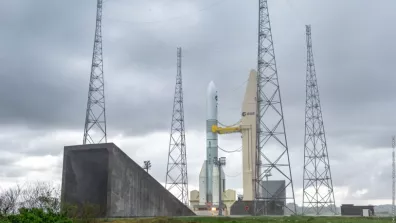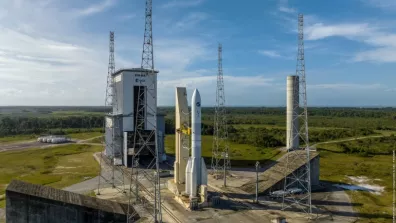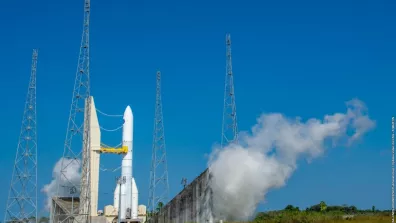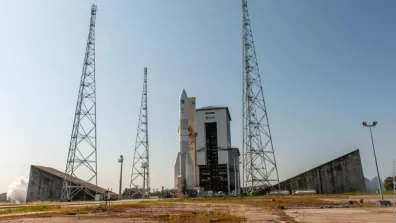The Ariane 6 Launcher Task Force consists of top management of ESA, as the overall Ariane 6 procuring entity and launch system architect, of the French space agency CNES, as the launch base prime contractor, of ArianeGroup as the launcher system prime contractor and of Arianespace as the launch service provider. This group reports regularly on progress being made towards inaugural flight of the new Ariane 6 launcher.
Key milestones towards inaugural flight
On the way towards the first flight of Ariane 6, two more rehearsals have been conducted since the last joint update:
15 December 2023: Combined test loading 3 (CTLO3), Kourou, French Guiana
On 15 December, 2023, teams from ArianeGroup, the French Space Agency (CNES), and the European Space Agency (ESA) successfully carried out another launch sequence of Ariane 6 on its launch pad at Europe’s Spaceport, French Guiana, for the combined test campaign.
The combined test loading (CTLO3) tested a launch countdown aimed to qualify the launch system in degraded conditions to ensure its robustness and prepare for operations. It was run the same way as the previous ones, with a launch sequence and final countdown representative of a launch, including removal of the mobile gantry as well as filling and draining of the launcher’s upper and core stage tanks with liquid hydrogen (-253 °C) and liquid oxygen (-183 °C). This test sequence included qualification tests of several launch system functions in case of aborted launch and included one ignition of the Vulcain 2.1 engine thrust chamber.
This was the fifth countdown run to include loading Ariane 6 with cryo-propellants since July.
The rehearsal was very well executed, and the countdown ran exactly as planned. The test was a full success and the task force thanks all teams involved.
The launch operations for Ariane 6 are mastered, we are ready to go.
7 December 2023: Upper stage firing test, Lampoldshausen, Germany
Having already qualified for flight after rigorous tests under routine conditions, Ariane 6's upper stage was pushed to its limits last week. The goal of the hot-fire test (HFT-4) on 7 December at the German Aerospace Center (DLR) test facility in Lampoldshausen, Germany, was to reproduce a normal start of a flight with the restartable Vinci engine and Auxiliary Power Unit (APU), and then to introduce degraded conditions to assess the robustness of the stage and how it would behave in extreme and unexpected conditions.
Two minutes after the Vinci engine and APU were fired up, the test was automatically aborted when sensors detected that some parameters had gone beyond predetermined thresholds. The engines were shut down with the nominal sequence, the upper stage test model and test bench entered a safe condition, and the tanks were emptied.
This HFT-4 test went beyond the normal flight profile for Ariane 6. The stage will not operate in such a test configuration on the inaugural flight. Teams are analysing test hardware and investigating possible root causes of the abort, with results expected mid-January 2024. More details will be given after the next Task Force meeting. We are confident that these investigations will not impact the schedule to Ariane 6 inaugural flight.
Next milestones
End January 2024: disconnection tests of the cryo-connection system
A rehearsal of disconnecting the upper and lower fuelling arms that support the umbilicals that supply Ariane 6 with liquid hydrogen and oxygen. The same umbilicals allow the propellant to be drained safely if a launch is aborted.
Mid-February: Arrival of first flight elements in French Guiana
The stages for the first Ariane 6 flight will arrive by Canopée ship in Kourouin French Guiana.
First flight period
ESA, CNES and ArianeGroup are targeting the first launch of Ariane 6 between mid-June and end of July 2024.
Ariane 6 is an all-new design, created to succeed Ariane 5 as Europe's heavy-lift launch system. With Ariane 6's upper stage restart capability, Europe's launch capability will be tailored to the needs of multiple payload missions, for example to orbit satellite constellations. This autonomous capability to reach Earth orbit and deep space supports Europe's navigation, Earth observation, scientific and security programmes. Ongoing development of Europe's space transportation capabilities is made possible by the sustained dedication of thousands of talented people working in ESA's 22 Member States.





